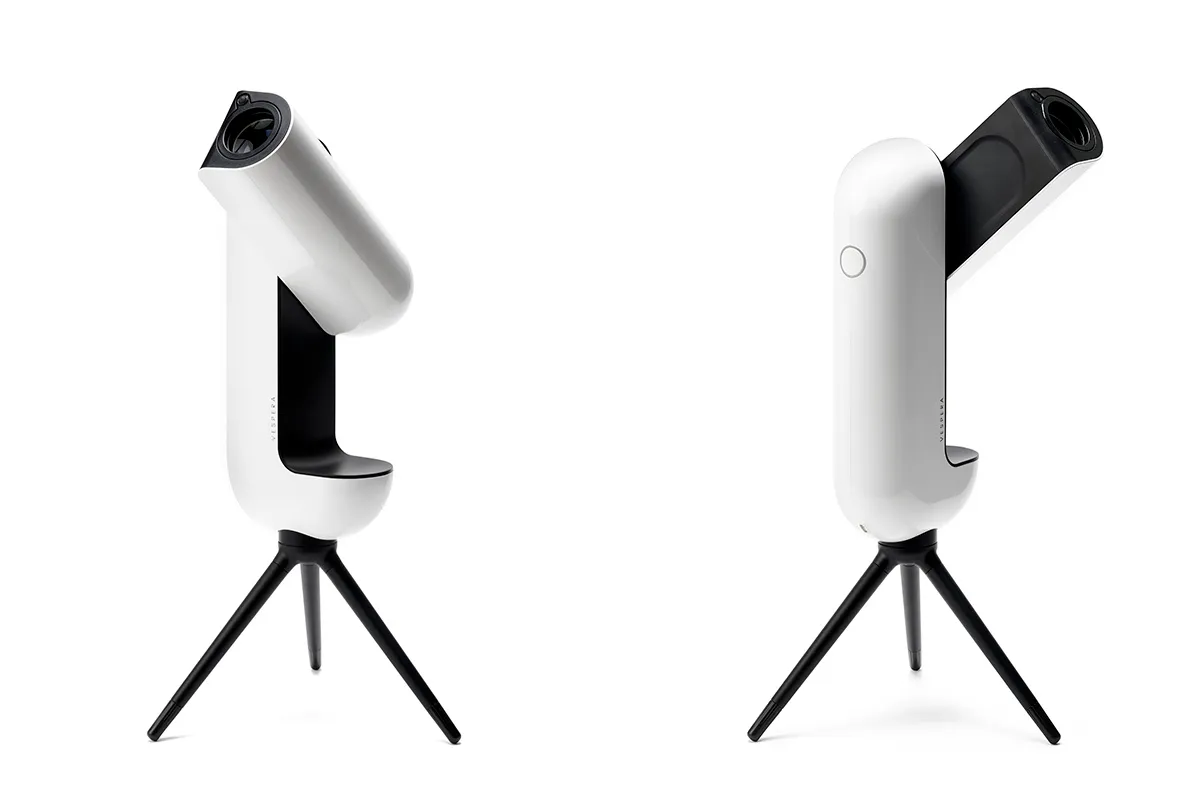Ever heard of a smart telescope? These high-tech gadgets are simple to use, but the results can be stunning.
You don’t use smart telescopes in the way you would use a traditional telescope, as smart telescopes display images on a screen.
A typical smart telescope consists of a computerised mount supporting a compact optical telescope.
These are EAA (Electronically Assisted Astronomy) devices and their mounts are typically designed for altaz (left–right and up–down) operation, while an onboard computer emulates equatorial tracking.
This cost-effective solution to scope mounting does come at a price though, as images captured over long periods suffer from an effect called field rotation.

Controlling a smart telescope
Smart telescopes are usually controlled with a smartphone or tablet app that helps you search for celestial targets, and tweak the settings and imaging controls.
In many cases, all you need to do is to pick a target on the app, and let the telescope find it and then start capturing it.
Imaging is done using short exposures, which reduces the effects of field rotation; the captured images are then stacked live on your phone or tablet.

The initial image normally looks a bit rough, but as the scope continues to accumulate data, it soon reveals the subject’s true glory.
To navigate the sky, the scope uses the current date, time and location, while an internal compass points the scope near the area of sky containing the target.
A level base is needed to do this successfully, and various models will even help you ensure the mount is levelled before you start.
Once in the general vicinity, plate-solving – where a bit of sky is imaged, and the stars then matched to an internal database – is used to refine pointing accuracy.
This allows the scope to accurately centre on a high percentage of chosen targets.
This technique can struggle, though, if sky conditions are poor, the object is very low or if you want to find a bright target such as the Sun or the Moon that negates the use of plate-solving.

Pros and cons of using a smart telescope
Many smart scopes have small apertures, more comparable to what you’d find on a finderscope.
This reduces the view’s resolution, so that detail on the Sun or Moon is okay, but easily beaten by more conventional setups.
However, for images of deep-sky objects or even just stars, the results are pretty respectable.

What’s more, these instruments seem to have rekindled the pioneering instinct, with some owners pushing theirs to produce genuine scientific data for areas of astronomy such as astrometry (the positional measurements of stars and other celestial objects) and photometry (determining the brightness of objects).
Coupled with very quick set-up and rapid target acquisition, what may at first resemble a toy or gimmick actually turns out to be a valuable astronomical tool.
This is amplified by captured images being automatically data-stamped with useful information, including the all-important date and time of capture.
One area where smart telescopes don’t work so well, however, is planetary imaging.
Their apertures are too small and focal lengths too short to get any serious image scale.

That’s not to say you can’t record things like Saturn’s rings or Jupiter’s belts and brighter moons, but currently smart scopes are no match for a dedicated planetary imaging setup.
As previously mentioned, you don’t look through a smart scope; it acquires image data with its sensor, sending this live-stacked result to your device, typically a phone or tablet.
Currently, there’s no way to vary image scale as you would with, for example, a Barlow lens on a traditional telescope.
However, some models do have the option to switch between different focal lengths, and offer both mid- and widefield coverage.

If you want to improve on the images your smart scope creates, you can process them yourself by accessing individually captured sub-frames.
The short-exposure, multi-image capture model of smart telescopes also allows you to use processing methods such as ‘drizzling’ to increase the apparent resolution of an image.
Any limitations in frame coverage can also be overcome to some extent by creating mosaics, and some smart telescopes even provide this facility as standard.

Using filters
Most smart telescopes are ideal portable instruments for transporting to dark-sky locations.
You can also simply stick your smart scope outside in your garden when clear conditions present themselves and start observing the night sky.
But what if your skies are less than pristine and badly affected by light pollution?
Many models come with switchable light-pollution filters, typically dual-band pass filters that allow you to capture nebulae with greatly reduced light-pollution interference.
Some smart scopes, such as the Celestron Origin, even allow you to insert your own filters.
Some models also come with a solar filter that’s fitted manually. These neutral-density filters dim the Sun’s light enough to make it safe for white-light solar observing.

Online community
Smart telescopes also provide one interesting upside: for each telescope make and model, the optical characteristics will, on paper at least, be identical and provide a kind of instrument calibration.
Basically, every owner uses the same kit.
As a result, this data can be combined via the internet, essentially creating a larger networked telescope and an online community of users.

What smart telescopes are best at
But how do smart telescopes shape up in terms of the astronomical experience? Frankly, apart from the odd issue where plate-solving fails, they are impressive to use.
This is especially true in parts of the world where long periods of clear weather can be few and far between.
The ability to be out and imaging in minutes is a godsend, because it allows you to take full advantage of small gaps in the weather.
What’s more, if clouds return intermittently, many smart scopes simply pause the capture and restart when clear skies return.

For variable star work, smart scopes have great potential, locating targets quickly and collecting results in less time than many traditional setups could achieve.
For deep-sky imaging, smaller apertures don’t compete as well as larger setups costing multiple thousands of pounds, but the difference may not be as great as you might expect.
This has led to accusations of smart scopes deskilling astrophotography, echoing similar complaints levied against digital imaging when it slowly edged film astrophotography out of the way a few decades ago.
All smart scopes perform live stacking, producing results that can be shared digitally in moments.

Access to the individual sub-frame images, typically in FITS format (Flexible Image Transport System, a file format used for the storage, transmission and processing of scientific data), allows you to take control and do your own image processing.
Many smart scopes have internal routines that do a decent job of image processing the final stacked image.
However, if you’re fluent in image processing techniques and have the appropriate software to hand, it’s certainly possible to do a better job.

The future
There’s no denying that smart scopes are an interesting addition and evolution to the world of astronomy.
Their convenience allows them to be used by experienced astronomers and beginners alike, and despite the fear of deskilling or dulling the astrophotography experience, they are simply a tool just like any other piece of kit – one that will give more out, the more you put into it.
Ultimately, such devices will generate more interest in astronomy, which can only be a good thing as it boosts the market, creates demand and leads to further advances.
With their popularity increasing, manufacturers will be looking at introducing more capabilities, such as better planetary imaging options.
But herein lies a problem, because increased size will bump up the cost towards that of dedicated conventional setups.
More traditional kit does have the advantage of allowing you to evolve equipment in stages, although smart scopes such as Celestron’s Origin, designed to accept future sensor upgrades, have admittedly partially addressed this.
5 smart telescopes scopes we'd recommend
DwarfLab Dwarf III

- Stats: 35mm (tele) and 3.4mm (wide) aperture, 737mm and 45mm equivalent focal lengths,
Sony IMX678 STARVIS 2 sensor - Size: An ultra-portable 222 x 142 x 65mm, 1.3kg
- Filters: Three built-in filters: visual, infrared and dual-band
- Verdict: Inexpensive smart scope system
Read our full Dwarflab Dwarf 3 review
SQUIRREL_13354904
ZWO SeeStar S50

- Stats: 50mm aperture, 250mm focal length, apochromatic triplet lens, Sony IMX642 sensor
- Size: Portable device at 143 x 130 x 257mm, 2.5kg. Tripod adds 0.65kg and EPP case adds 0.6kg
- Filters: One built-in dual-band filter, plus one additional solar filter supplied
- Verdict: Inexpensive smart scope
Read our full SeeStar S50 review
SQUIRREL_13054573
Celestron Origin

- Stats: 152mm aperture, 334mm focal length f/2.2 Rowe-Ackermann Schmidt design, Sony IMX178LQJ sensor
- Size: Tube 610 x 178mm, 4.8kg; mount 457 x 305 x 254mm, 7.7kg. Total for tripod and tube together 18.9kg
- Filters: Filter drawer, 1.25-inch or 2-inch filters accepted
- Verdict: Expensive, high-end smart scope
SQUIRREL_13354930
Vaonis Vespera Pro

- Stats: 50mm aperture, 250mm focal length, apochromatic quadruplet lens, 12.5MP, Sony IMX676 STARVIS 2 sensor, 11-hour battery life
- Size: 480 x 200 x 90mm, 5kg
- Filters: Optional filters available include solar, light pollution and dual-band
- Verdict: Expensive, high-end smart scope
Read our full Vaonis Vespera II review
SQUIRREL_13052197
Unistellar Odyssey Pro

- Stats: 85mm aperture, 320mm focal length, IMX415 sensor, electronic eyepiece for immersive experience, able to send images to phone or tablet
- Size: 432 x 203 x 13mm, 6.5kg
- Filters: Optional solar filter available
- Verdict: Expensive high-end scope
Read our full Unistellar Odyssey Pro review
SQUIRREL_13052611
8 great targets for smart telescope beginners
The Orion Nebula
A classic target within the Sword of Orion, the Orion Nebula is large, detailed and bright.
The Andromeda Galaxy
The Andromeda Galaxy is a popular target, but smart scopes with smaller sky coverage will make you think about framing. A great introduction for those who want to hone their processing skills and try multi-image mosaics.
The Pleiades
Like M31, the Pleiades open cluster, M45, is a large target, not fully covered by smaller smart scope setups. Despite this, focus on the faint and delicately laced reflection nebula around Merope.
The Crab Nebula
The Crab Nebula is a bright supernova remnant and a great target for smart telescopes, with interesting filamentary detail and good colour.
The Rosette Nebula
The Rosette Nebula is too large for many smart telescopes. Highly detailed, instead use this as a wonderful opportunity to create a mosaic.
Thor's Helmet Nebula
Thor’s Helmet has some excellent detailing that smart telescopes pick up very well.
The Triangulum Galaxy
The Triangulum Galaxy is a good fit for many smart scopes. Longer stacked sessions really bring out some interesting detail.
The Whirlpool Galaxy
The Whirlpool Galaxy is a classic, iconic deep-sky object with good size and lots of detail – an ideal target for smart telescopes.
M78
Messier 78 is beautiful, bright reflection nebula in Orion that you’ll find really benefits from long capture sessions.
Share your best smart telescope images with us by emailing contactus@skyatnightmagazine.com

